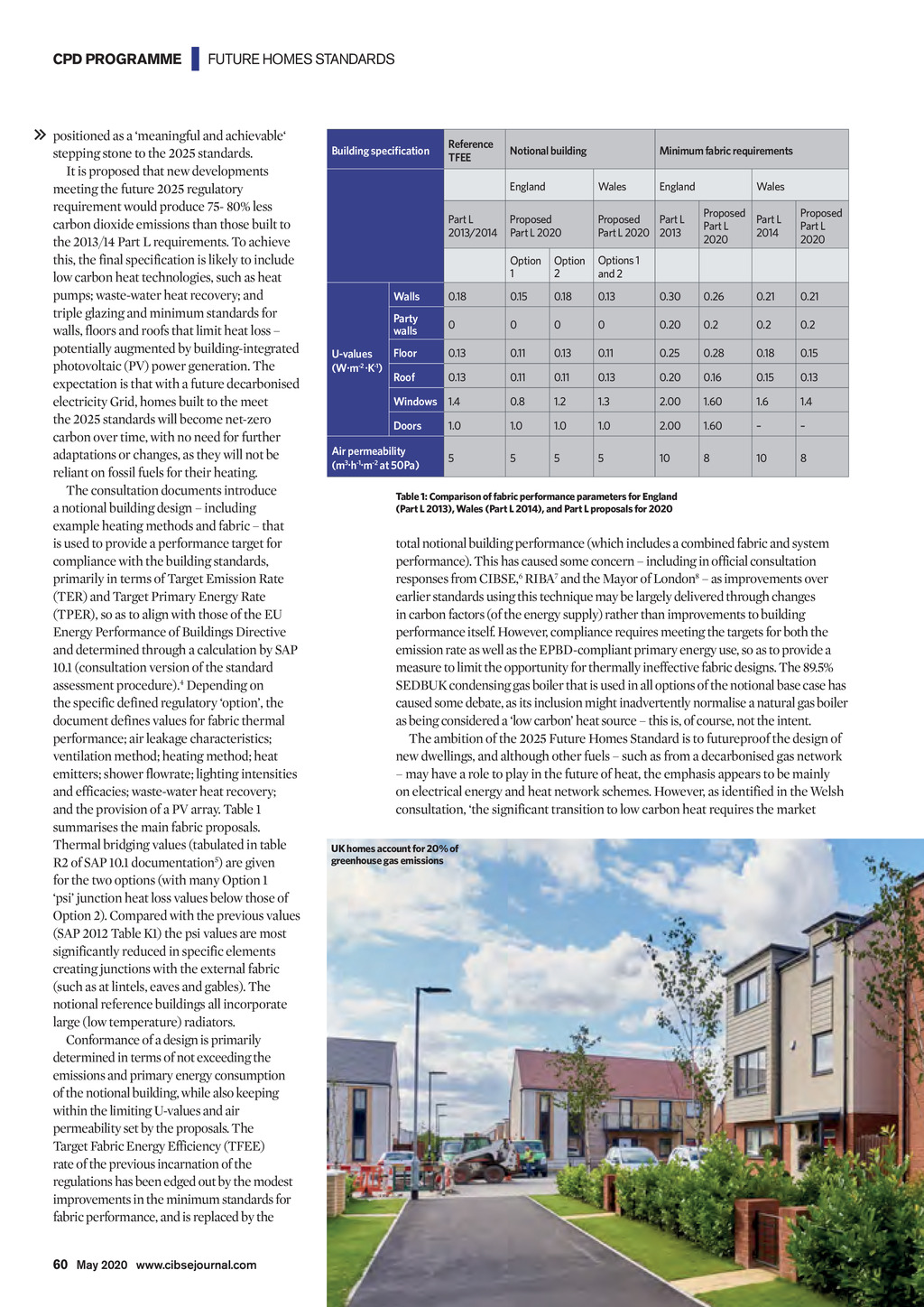




CPD PROGRAMME | FUTURE HOMES STANDARDS positioned as a meaningful and achievable stepping stone to the 2025 standards. It is proposed that new developments meeting the future 2025 regulatory requirement would produce 75- 80% less carbon dioxide emissions than those built to the 2013/14 Part L requirements. To achieve this, the final specification is likely to include low carbon heat technologies, such as heat pumps; waste-water heat recovery; and triple glazing and minimum standards for walls, floors and roofs that limit heat loss potentially augmented by building-integrated photovoltaic (PV) power generation. The expectation is that with a future decarbonised electricity Grid, homes built to the meet the 2025 standards will become net-zero carbon over time, with no need for further adaptations or changes, as they will not be reliant on fossil fuels for their heating. The consultation documents introduce a notional building design including example heating methods and fabric that is used to provide a performance target for compliance with the building standards, primarily in terms of Target Emission Rate (TER) and Target Primary Energy Rate (TPER), so as to align with those of the EU Energy Performance of Buildings Directive and determined through a calculation by SAP 10.1 (consultation version of the standard assessment procedure).4 Depending on the specific defined regulatory option, the document defines values for fabric thermal performance; air leakage characteristics; ventilation method; heating method; heat emitters; shower flowrate; lighting intensities and efficacies; waste-water heat recovery; and the provision of a PV array. Table 1 summarises the main fabric proposals. Thermal bridging values (tabulated in table R2 of SAP 10.1 documentation5) are given for the two options (with many Option 1 psi junction heat loss values below those of Option 2). Compared with the previous values (SAP 2012 Table K1) the psi values are most significantly reduced in specific elements creating junctions with the external fabric (such as at lintels, eaves and gables). The notional reference buildings all incorporate large (low temperature) radiators. Conformance of a design is primarily determined in terms of not exceeding the emissions and primary energy consumption of the notional building, while also keeping within the limiting U-values and air permeability set by the proposals. The Target Fabric Energy Efficiency (TFEE) rate of the previous incarnation of the regulations has been edged out by the modest improvements in the minimum standards for fabric performance, and is replaced by the Building specification Reference TFEE Part L 2013/2014 Notional building Minimum fabric requirements England Wales England Proposed Part L 2020 Proposed Part L Part L 2020 2013 Option 1 Option 2 Options 1 and 2 Wales Proposed Part L Part L 2014 2020 Proposed Part L 2020 Walls 0.18 0.15 0.18 0.13 0.30 0.26 0.21 0.21 Party walls 0 0 0 0 0.20 0.2 0.2 0.2 0.13 0.11 0.13 0.11 0.25 0.28 0.18 0.15 0.13 0.11 0.11 0.13 0.20 0.16 0.15 0.13 Windows 1.4 0.8 1.2 1.3 2.00 1.60 1.6 1.4 Doors 1.0 1.0 1.0 1.0 2.00 1.60 5 5 5 5 10 8 10 8 Floor U-values (W.m-2 .K-1) Roof Air permeability (m3.h-1.m-2 at 50Pa) Table 1: Comparison of fabric performance parameters for England (Part L 2013), Wales (Part L 2014), and Part L proposals for 2020 total notional building performance (which includes a combined fabric and system performance). This has caused some concern including in official consultation responses from CIBSE,6 RIBA7 and the Mayor of London8 as improvements over earlier standards using this technique may be largely delivered through changes in carbon factors (of the energy supply) rather than improvements to building performance itself. However, compliance requires meeting the targets for both the emission rate as well as the EPBD-compliant primary energy use, so as to provide a measure to limit the opportunity for thermally ineffective fabric designs. The 89.5% SEDBUK condensing gas boiler that is used in all options of the notional base case has caused some debate, as its inclusion might inadvertently normalise a natural gas boiler as being considered a low carbon heat source this is, of course, not the intent. The ambition of the 2025 Future Homes Standard is to futureproof the design of new dwellings, and although other fuels such as from a decarbonised gas network may have a role to play in the future of heat, the emphasis appears to be mainly on electrical energy and heat network schemes. However, as identified in the Welsh consultation, the significant transition to low carbon heat requires the market UK homes account for 20% of greenhouse gas emissions 60 May 2020 www.cibsejournal.com CIBSE May 20 pp59-62 CPD Glen Dimplex 161 v2.indd 60 24/04/2020 16:41